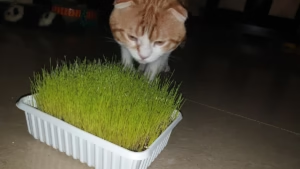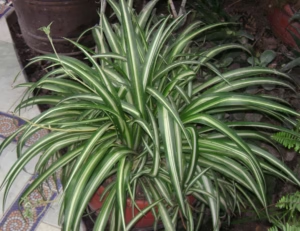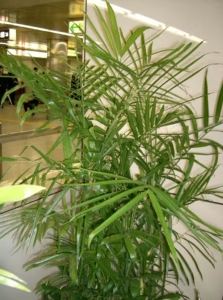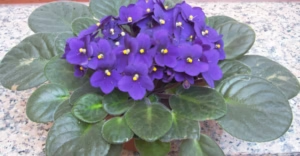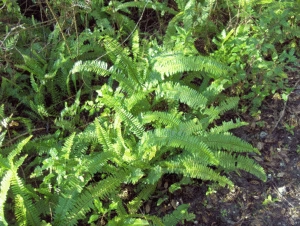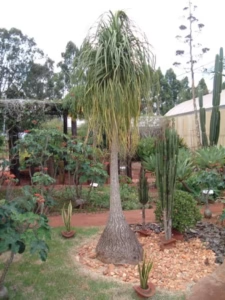Creating a lush indoor jungle when you have cats requires a delicate balance between satisfying your plant parent aspirations and ensuring your feline friends remain safe.
Many popular houseplants contain toxic compounds that can harm cats if ingested, leading to symptoms ranging from mild digestive upset to serious health emergencies. Fortunately, there’s no need to choose between your cats and your love of greenery, plenty of beautiful, pet-friendly plants can thrive in your home without posing risks to your curious companions.
This comprehensive guide focuses on three standout cat-safe options, cat grass, spider plants, and bamboo palms, while also exploring other feline-friendly additions to your indoor jungle. By the end, you’ll have all the knowledge needed to create a stunning plant collection that both you and your cats can enjoy safely.
Understanding Plant Toxicity and Cats
Before diving into specific plant recommendations, it’s important to understand why plant toxicity matters for cat owners and how to recognize potential problems.
Why Cats Chew on Plants
Cats are naturally curious creatures, and plant-chewing behavior is common among indoor felines for several reasons:
- Instinctive behavior: In the wild, cats occasionally consume plant material to aid digestion and as a natural hairball remedy
- Nutritional supplementation: Some cats seek out plants to fulfill nutritional needs not met by their regular diet
- Behavioral enrichment: Indoor cats especially crave connection to nature and may chew plants as a form of environmental enrichment
- Texture and play: The interesting textures and movements of plants can trigger a cat’s play and predatory instincts
Understanding these motivations helps explain why providing cat-safe plants isn’t just about safety, it’s about meeting your cat’s natural needs in a controlled way.
Common Toxic Plants to Avoid
While this article focuses on safe options, it’s worth mentioning some common houseplants that should be kept far away from cats:
- Lilies (extremely toxic and potentially fatal)
- Pothos/Devil’s Ivy
- Philodendron
- Peace Lily
- Aloe Vera
- Snake Plant
- Monstera
- ZZ Plant
- Sago Palm
- English Ivy
Always research any new plant before bringing it into a home with cats, and when in doubt, consult resources like the ASPCA’s toxic plant database.
How Plant Toxicity Affects Cats
Understanding the mechanisms of plant toxicity can help cat owners better protect their pets. According to recent research published in the Journal of Veterinary Medicine (2024), cats are particularly vulnerable to plant toxins due to several physiological factors:
- Limited detoxification enzymes: Cats lack certain glucuronyl transferases, enzymes that help other mammals break down and eliminate toxins
- Sensitive gastrointestinal system: The feline digestive tract can absorb certain plant compounds more readily than other animals
- Grooming behavior: Cats’ meticulous grooming means they ingest residues that might be on their fur after contact with plants
- Small body mass: Even small amounts of toxins can have significant effects due to cats’ relatively small size
Different toxic plants affect cats through various mechanisms:
- Calcium oxalate crystals (found in philodendrons and pothos) cause immediate oral irritation and swelling
- Cardiac glycosides (in lilies) can cause severe kidney damage even in minute amounts
- Saponins (in dracaena plants) cause gastrointestinal upset and potential central nervous system effects
- Insoluble calcium oxalates (in dieffenbachia) create needle-like crystals that physically damage tissue
Recognizing early signs of plant toxicity, such as drooling, pawing at the mouth, vomiting, lethargy, or changes in urination, can be crucial for prompt veterinary intervention.
Cat Grass: A Feline Favorite
Cat grass isn’t just safe for cats, it’s specifically grown for them to enjoy! This makes it the perfect starting point for your cat-friendly indoor jungle.
Benefits of Cat Grass for Feline Health
Cat grass offers numerous health benefits for your feline companions:
- Digestive support: The fiber in cat grass helps stimulate digestion and assists in the smooth passage of hairballs through the gastrointestinal tract, potentially preventing blockages
- Nutritional boost: Cat grass is rich in essential nutrients including vitamins A and B, minerals like iron, and amino acids vital for maintaining a healthy metabolism
- Hairball management: Regular access to cat grass can help prevent hairball formation and reduce related symptoms
- Natural behavior outlet: Providing cat grass gives indoor cats a safe way to satisfy their instinctive grass-chewing behavior
- Environmental enrichment: Having their own fresh indoor garden helps satisfy cats’ connection to nature
How to Grow Cat Grass Indoors
Growing cat grass is surprisingly simple, making it perfect for even novice plant parents:
- Choose your seeds: Common options include wheat, barley, oat, and rye grasses
- Select a container: Use a shallow pot with drainage holes
- Prepare the soil: Fill the container with a high-quality potting mix
- Plant the seeds: Spread seeds evenly across the soil surface and cover with a thin layer of soil
- Water thoroughly: Keep the soil consistently moist until germination
- Place in indirect light: Cat grass prefers bright, indirect sunlight
- Harvest and maintain: Allow grass to grow 3-4 inches before offering to your cat, and replant every few weeks for a continuous supply
For busy cat parents, pre-grown cat grass kits are widely available at pet stores and online retailers.
Varieties of Cat Grass to Consider
While “cat grass” is often used as a general term, several specific varieties offer slightly different benefits:
- Wheatgrass: The most common type, known for its nutritional density and mild flavor
- Oat grass: Particularly high in fiber and often preferred by cats for its softer texture
- Barley grass: Contains high levels of chlorophyll and antioxidants
- Rye grass: Grows quickly and has a slightly sweeter taste that some cats prefer
You might want to experiment with different varieties to discover your cat’s preference, many cats have strong opinions about which type they enjoy most!
Spider Plants: The Perfect Hanging Companion
Spider plants (Chlorophytum comosum) are among the most popular houseplants, and fortunately, they’re also safe for cats, making them an excellent addition to your pet-friendly indoor jungle.
Spider Plant Benefits and Characteristics
Spider plants offer numerous advantages for cat-owning plant enthusiasts:
- Non-toxic safety: According to the ASPCA, spider plants are classified as non-toxic to both cats and dogs
- Air-purifying properties: Spider plants help improve indoor air quality by removing certain toxins
- Visual interest: The cascading nature of spider plant foliage creates dramatic visual appeal
- Easy propagation: The plant produces “spiderettes” (baby plants) that can be easily propagated
- Adaptability: Spider plants thrive in a variety of conditions, making them perfect for beginners
The distinctive arching leaves and dangling offshoots make spider plants particularly attractive to cats, who may bat at the “babies” like toys.
While this interaction can be entertaining, you’ll want to place the plants strategically to prevent excessive damage.
Spider Plant Care Guide
Spider plants are remarkably forgiving, but they’ll thrive with these care guidelines:
- Light: Prefers bright, indirect light but tolerates partial shade; too much direct sunlight can scorch the leaves
- Water: Keep soil moderately moist but not soggy; allow the top inch of soil to dry between waterings
- Soil: Plant in loose, loamy, well-draining soil
- Temperature: Thrives in normal household temperatures between 65-75°F (18-24°C)
- Humidity: Adapts to average household humidity but appreciates occasional misting
- Fertilizer: Feed with a balanced houseplant fertilizer every 2-3 months during growing season
- Repotting: Repot when roots become visible through drainage holes, typically every 1-2 years
Spider plants look particularly stunning in hanging baskets, which has the added benefit of keeping most of the plant out of your cat’s reach while still allowing them to occasionally interact with the dangling spiderettes.
Addressing the “Hallucinogenic” Myth
You may have heard rumors that spider plants have hallucinogenic effects on cats. Here’s the truth:
Spider plants contain compounds that are distantly related to opium, which may cause a mild hallucinogenic effect in cats. However, this effect is generally considered harmless. That said, excessive consumption can still cause digestive upset in some cats, resulting in vomiting or diarrhea.
Recent research from the University of California’s Veterinary Medicine department (2025) has clarified that while spider plants contain mild chemical compounds that can cause altered behavior in cats, these effects are temporary and non-harmful.
The study found that less than 5% of cats show any behavioral changes after spider plant consumption, and these changes typically resolve within 30-60 minutes.
While spider plants are officially classified as non-toxic, it’s still best to monitor your cat’s interaction with the plant and discourage excessive chewing.
Most cats will naturally limit their consumption, but if your cat seems obsessed with your spider plant, consider placing it completely out of reach or providing alternative cat-safe plants like cat grass to redirect their attention.
Bamboo Palm: Tropical Vibes with Cat Safety
For cat owners seeking to add height and tropical flair to their indoor jungle, the bamboo palm (Chamaedorea seifrizii) is an excellent choice.
Bamboo Palm Features and Benefits
The bamboo palm offers numerous advantages for cat-owning plant enthusiasts:
- Cat-safe certification: Bamboo palms are non-toxic to cats and dogs, approved by veterinarians and toxicologists
- Air-purifying qualities: Like many palms, bamboo palms help filter indoor air
- Tropical aesthetic: Their lush, feathery fronds bring a tropical vibe to any space
- Substantial size: Can grow up to 4-7 feet tall indoors, adding dramatic height to your plant collection
- Shade tolerance: Thrives in lower light conditions where many other plants struggle
It’s important to note that while the true bamboo palm is safe for cats, the similarly named “lucky bamboo” (Dracaena sanderiana) is toxic to cats.
Always verify the scientific name when purchasing plants marketed as “bamboo.”
Caring for Your Bamboo Palm
Bamboo palms are relatively low-maintenance but will thrive with these care guidelines:
- Light: Prefers bright, indirect light but tolerates lower light conditions; avoid direct sunlight
- Water: Keep soil consistently moist but not soggy; water when the top inch of soil feels dry
- Soil: Use well-draining, rich potting mix
- Temperature: Maintains best growth between 65-80°F (18-27°C); protect from drafts and sudden temperature changes
- Humidity: Appreciates higher humidity; consider misting regularly or using a humidifier
- Fertilizer: Feed with a balanced houseplant fertilizer diluted to half strength every 2-3 months during growing season
- Pruning: Remove any yellow or brown fronds at the base to maintain appearance
One advantage of bamboo palms is that their fronds typically grow beyond the reach of most cats, making them less likely to suffer damage from curious paws and teeth.
Cat-Safe Plant Comparison Table
| Plant | Light Needs | Water Frequency | Humidity | Growth Rate | Special Features | Cat Appeal |
| Cat Grass | Bright indirect | Daily until germination, then every 2-3 days | Average | Very fast (7-10 days) | Digestive benefits | Very high |
| Spider Plant | Bright indirect to partial shade | When top inch of soil dries | Average to high | Moderate | Air-purifying, easy propagation | High (especially the “babies”) |
| Bamboo Palm | Bright indirect to low light | When top inch of soil dries | High | Slow to moderate | Tropical appearance, height | Low (usually out of reach) |
| African Violet | Bright indirect | When soil surface feels dry | Average | Slow | Colorful flowers | Low |
| Boston Fern | Bright indirect | Keep consistently moist | Very high | Moderate | Lush, dramatic foliage | Medium |
| Ponytail Palm | Bright light | Every 2-3 weeks | Low to average | Very slow | Unique appearance, drought-tolerant | Low |
Additional Cat-Safe Plants for Your Indoor Jungle
While cat grass, spider plants, and bamboo palms form an excellent foundation for your cat-friendly indoor jungle, many other non-toxic options can add variety and visual interest.
African Violets: Colorful and Cat-Friendly
African violets (Saintpaulia ionantha) are one of the most popular flowering houseplants and completely safe for cats:
- Vibrant blooms: Available in shades of purple, pink, and white
- Compact size: Perfect for smaller spaces at just 9 inches tall and wide
- Indoor adaptability: Thrive in the same environments humans prefer—moderate temperatures and average humidity
- Care requirements: Prefer soil-free potting mix, bright indirect light, and watering from the bottom
These charming plants add a pop of color to your cat-safe plant collection without taking up much space.
Boston Ferns: Lush Greenery for Cats
Boston ferns (Nephrolepis exaltata) offer dramatic texture and lush foliage while remaining completely cat-safe:
- Dramatic fronds: Shaggy, arching fronds create visual interest
- Versatile display options: Ideal for pots or hanging baskets
- Air-purifying benefits: Excellent at removing indoor air pollutants
- Care requirements: Prefer high humidity, bright indirect light, and consistently moist soil
While cats may occasionally nibble on the fronds, Boston ferns pose no toxicity risk to your feline friends.
Ponytail Palms: Unique and Safe
Despite their name, ponytail palms (Beaucarnea recurvata) aren’t true palms but are equally safe for cats:
- Distinctive appearance: Features a thick, bulbous trunk and long, cascading fronds
- Drought tolerance: Extremely forgiving of irregular watering
- Longevity: Can live for many years as a houseplant
- Care requirements: Prefers bright light, well-draining soil, and infrequent watering
The unique appearance of ponytail palms makes them a conversation piece in any indoor jungle, and their cat-safe status means you can display them with confidence.
Creating a Cat-Friendly Plant Environment
Successfully maintaining both cats and plants requires thoughtful planning beyond simply choosing non-toxic species.
Strategic Plant Placement
Consider these strategies for plant placement in a cat-friendly home:
- Hanging planters: Keep tempting plants like spider plants elevated but visible
- Plant shelves: Install dedicated shelving for plants that’s difficult for cats to access
- Grouping strategy: Place less interesting plants (to cats) on the floor and more tempting ones out of reach
- Designated plant room: If space allows, consider a “plant room” with a door that can be closed when supervision isn’t possible
- Rotation system: Rotate plants between accessible and inaccessible locations to manage damage
Remember that even non-toxic plants can cause digestive upset if consumed in large quantities, so monitoring access remains important.
Enrichment Through Plant Selection
Strategic plant choices can enhance your cat’s environment:
- Textural variety: Include plants with different textures to stimulate your cat’s sensory experience
- Interactive elements: Plants with movement (like spider plant babies) provide entertainment
- Dedicated cat plants: Designate certain plants specifically for cat interaction
- Sensory garden: Create a small container garden with cat grass, catnip, and other cat-friendly herbs
- Foraging opportunities: Hide treats among cat-safe plants to encourage natural foraging behaviors
By intentionally incorporating plants that serve both aesthetic and enrichment purposes, you create an environment that benefits both you and your feline companions.
Troubleshooting Common Issues
Even with careful planning, challenges can arise when maintaining plants in a cat-friendly home.
When Cats Won’t Leave Plants Alone
If your cat seems obsessed with your houseplants:
- Increase cat grass access: Ensure plenty of cat grass is available as an alternative
- Add deterrents: Consider pet-safe plant deterrent sprays or placing citrus peels in soil
- Provide alternatives: Increase environmental enrichment with cat toys, climbing opportunities, and dedicated play sessions
- Create barriers: Use decorative stones to cover soil (preventing digging) or place plants inside decorative cages
- Redirect behavior: Use positive reinforcement to train cats to interact appropriately with plants
Patience and consistency are key, most cats can learn to coexist peacefully with houseplants given time and proper training.
Signs of Plant Stress
Watch for these indicators that your plants may be suffering from cat interaction:
- Broken stems or leaves: Physical damage from chewing or playing
- Disturbed soil: Signs of digging or using the pot as a litter box
- Yellowing leaves: Can indicate stress from physical damage
- Stunted growth: Repeated damage can slow or stop plant growth
- Root exposure: Soil displacement from digging can expose and damage roots
Address these issues promptly to maintain plant health, adjusting your strategy as needed to protect vulnerable specimens.
Conclusion
Creating a cat-friendly indoor jungle is entirely possible with the right plant selection and strategic planning. Cat grass provides health benefits and satisfies natural chewing instincts, spider plants offer visual interest and interactive elements, and bamboo palms add dramatic height and tropical flair, all while keeping your feline friends safe.
By expanding your collection with other non-toxic options like African violets, Boston ferns, and ponytail palms, you can create a diverse, visually stunning plant collection that coexists harmoniously with your cats.
Remember that even with non-toxic plants, moderation is key, excessive consumption of any plant material can cause digestive upset in cats.
By providing dedicated cat plants like cat grass, strategically placing other houseplants, and creating an enriching environment for your cats, you can enjoy the benefits of indoor gardening without compromising your pets’ safety.
With thoughtful planning and the plant recommendations in this guide, both you and your cats can enjoy the beauty, improved air quality, and natural elements that houseplants bring to your home.
FAQs About Cat-Safe Plants
- Can cats get sick from eating spider plants even though they’re non-toxic?
While spider plants are classified as non-toxic to cats, excessive consumption can still cause mild digestive upset in some cats, resulting in vomiting or diarrhea. The compounds in spider plants may produce a mild hallucinogenic effect, though this is generally considered harmless. It’s best to monitor your cat’s interaction with spider plants and provide alternatives like cat grass if they seem overly interested. - How often should I replace my cat grass to keep it fresh?
Cat grass typically remains vibrant for 2-3 weeks before beginning to yellow and wilt. For the best experience, consider maintaining a rotation system with new seeds planted every 7-10 days, ensuring you always have fresh grass available for your cat. Many cat owners find that keeping 2-3 containers at different growth stages works well for continuous access. - My bamboo palm’s leaves are turning brown at the tips, is this normal?
Brown tips on bamboo palm fronds usually indicate either underwatering, low humidity, or salt buildup from fertilizer. Try increasing humidity around the plant by misting regularly or using a humidifier. Also, ensure you’re watering thoroughly when the top inch of soil feels dry, allowing excess water to drain completely. If you suspect fertilizer buildup, flush the soil thoroughly with distilled water. - Can I use regular grass from my lawn instead of buying cat grass?
While cats may enjoy nibbling on lawn grass, it’s not ideal for indoor cats for several reasons. Lawn grass often contains pesticides, herbicides, or environmental pollutants that could harm your cat. Additionally, common lawn grasses have serrated edges that can irritate a cat’s throat and digestive system. Purpose-grown cat grass has smoother blades and is specifically cultivated to be safe and digestible for cats. - What should I do if my cat keeps digging in my plant pots despite having cat-safe options?
Digging is a natural behavior for cats, but it can damage your plants. Try covering the soil surface with decorative rocks, river stones, or a layer of moss to make digging less appealing. You might also provide a dedicated digging box filled with plant-safe soil or coconut coir where this behavior is allowed. For persistent diggers, consider using double-potting (placing the plant pot inside a slightly larger decorative pot) with a barrier between them, or using plant stands to elevate pots beyond your cat’s reach.


